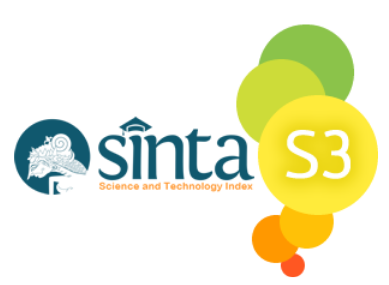CLASSROOM ENVIRONMENT, STUDENTS MOTIVATION, AND SPEAKING ANXIETY AMONG VOCATIONAL HIGH SCHOOL STUDENTS IN ENGLISH LESSON
Abstract
Students in vocational high school mostly not acknowledge English language well because they are only focused in learning about the major material. In other words, while vocational high school students are learning English particularly in speaking skill there is an issue followed in acquiring the language which is speaking anxiety. Students feel anxious in speaking for the reason such as motivation and environment which make it difficult to comprehend it. This study aims at finding out the extent between classroom environment and students motivation towards speaking anxiety of vocational high school students using correlation method to discover the relationship. The subjects of this study were 105 students of first grade of beauty, culinary art major and second grade of design maker, design fashion in SMKN 3 Malang. The method of this study was quantitative with partial correlation design. This study used three kinds of questionnaire as the research instruments which are Public Speaking Class Anxiety Scale (PSCAS), Attitude/Motivation Test Battery (AMTB) and Students Satisfaction of Classroom Environment (SSCE). The collected date would be analysed using Pearson Product Moment in SPSS. This study revealed that the correlation between classroom environment and speaking anxiety is 0.172 and the significance value is 0.0089 < 0,05 that can be interpreted as positive correlation but it is very weak correlation, the correlation between motivation and speaking anxiety is - 0.139 and the significance value is 0.0170 > 0,05 that can interpreted as a negative correlation or no correlation at all. It is shown that the correlation between classroom environment (X1) and students motivation (X2) towards speaking anxiety (Y) is rejected or there is o correlation among variables. However, the correlataion between classroom environment and motivation os 0.289 with significance value 0.003<0,05 which means weak correlation. It can be assumed that classroom environment and motivation are not really associated with students speaking anxiety.
Keywords
Full Text:
PDFReferences
Abdi, Herve. Part (Semi Partial) and Partial Regression Coefficients. Retrieved from https://www.utdallas.edu/~herve/Abdi Partial Regression Coefficient 2007-pretty.pdf on May 8, 2018
Adesua, V.O. (2014). Motivation and Academic Performance Senior Secondary School Students in South West Nigeria. Unpublished Ph.D. Thesis. Ekiti State University, Ado-Ekiti.
Akomolafe. O.C & Adesua, V.O. (2015). The Classroom Environment: A Major Motivating Factor towards High Academic Performance of Senior Secondary School Students in South West Nigeria. Journal of Education and Practice, Vol.6 No. 34
Arikunto, S. (2006). Prosedur penelitian suatu pendekatan praktik. Jakarta: Rineka Cipta.
Aqil, R. H. (2018). The Correlation Between The Students’ Intercultural Sensitivity And Motivation In Learning Foreign Language (Unpublished Undergraduate Thesis). Universitas Brawvfcijaya
Asiyai, R. (2014). Students' Perception of the Condition of Their Classroom Physical Learning Environment and Its Impact on Their Learning and Motivation. College Students Journal. 48 (4). 716-726.
A. E. Woolfolk, (1990). Educational Psychology, Allyn & Bacon, Boston, Mass, USA, 4th edition,
Bailey, P., Onwuegbuzie, A. J. & Daley, C. E. (2000). Correlates of anxiety at three stages of the foreign language learning process. Journal of Language and Social Psychology, 19 (4), 474-490
Bergil, A. S. (2016). The Influence Of Willingness To Communicate On Overall Speaking Skills Among EFL Learners. Procedia-Social and Behavioral Sciences, 232, 177-187. https://doi.org/10.1016/j.sbspro.2016.10.043
Bickerstaffe, D. (1980). And so To Teach. A General Methods Course. Ibadan. Evans Brothers. Nigeria Publishers. Ltd.
Bima, Fadjar M. (2020). The Correlation between Classroom Environment and
Students Motivation Towards Speaking Anxiety of Vocational High School Students In Learning English. Unpublished Undergraduate Thesis. Fakultas Ilmu Budaya Universitas Brawijaya
Bungin, H. M. B. (2005). Metode Penelitian Kuantitatif: Komunikasi, Ekonomi, dan Kebijakan Publik Serta Ilmu-Ilmu Sosial Lainnya. Jakarta: Kencana.
Burns, A., & Joyce, H. (1997). Focus on speaking. Sydney: National Center for English Language Teaching and Research.
Chou Mu-Hsuan. (2018). Speaking Anxiety and Strategy Use for Learning English as a Foreign Language in Full and Partial English-Medium Instruction Contexts. TESOL Quaterly – International Association 2018. 52 (3). 611
Creswell, J. W. (2014). Research Design. SAGE Publications Ltd.
Creswell, J. W. (2009). Research design: Qualitative, quantitative, and mixed methods approaches. (third edition). Thousand Oaks, CA: Sage
Dornyei, Z. (1994). Motivation and motivating in the foreign language classroom. ¨Modern Language Journal, 78, 273–284.
Dornyei, Z. (2005). ¨ The psychology of the language learner: Individual differences in second language acquisition. Mahwah, NJ: Lawrence Erlbaum
Dörnyei, Z. (2009). The L2 motivational self system. In Z. Dörnyei & E. Ushida (Eds.), Motivation, language identity and the L2 self (pp. 9–42). Clevedon: Multilingual Matters.
Finocchiaro, M and Brumfit. (1983). The Functional National Approach: form Theory to Practice, New York: Oxford University Press
Fraenkel, J. R., Wallen, N. E., & Hyun, H. H. (2012). How to design and evaluate research in education (eight edition). New York: McGraw-Hill Companies
Goodlad, J. (1984). A Place Called School. New York: McGraw-Hill.
Gardner, R. C., & MacIntyre, P. D. (1992). A student’s contributions to second language learning. Part I: Cognitive variables. Language
Teaching, 25, 211-220.
Gardner, R. C., Day, J.B., & MacIntyre, P. D. (1992). Integrative motivation,
induced anxiety, and language learning in a controlled environment. Studies i n Second Language Acquisition, 14, 197-214Rahmatika, A. N. (2018) . Developing Esp Module Using Content-Based Instruction For Tenth Grade Of Cullinary Arts Students At SMKN 1 Cerme. (Doctoral dissertation, UNIVERSITAS MUHAMMADIYAH GRESIK).
Horwitz, E. K., Horwitz, M. B., & Cope, J. (1986). Foreign language classroom anxiety. The Modern Language Journal. 70 (2), 125-132.
Huang, Wenhong & Liu, Meihua, (2011). An Exploration of Foreign Language Anxiety and English Learning Motivation. Hindawi Publishing Corporation
Education Research International
Iurea, C. (2015).Classroom Environment between Stimulation and Discouragement Teacher’s Contribution to Creating a New Socio-affective Environment Favoring the Teacher-Student Communication. International Conference Education And Psychology Challenges – Teachers For The Knowledge Society - 3rd Edition, Epc-Tks.
Kemendikbud, RI. (2016). Undang – Undang Dasar Negara Republik Indonesia Tahun 2013, Nomor 20, Pasal 15. https://kelembagaan.ristekdikti.go.id/wpcontent/uploads/2016/08/UU_no_20_th_2003.pdf
Koch, A. S., & Terrell T. D. (1991). Affective Reactions Of Foreign Language Students To Natural Approach Activities And Teaching Procedures. In E. K. Horwitz, & D. J. Young (Eds.), Language Anxiety (pp. 109-125). London: Prentice Hall InternationalKurniawanti, Sitti. (2017). A Study of Speaking Class Anxiety of The Second Semester Students In English Education Department At UIN Alauddin Makasar (Unpublished Undergraduate Thesis). UIN Alauddin Makasar.
K. Ramage, (1990). “Motivational factors and persistence in foreign language study,” Language Learning, vol. 40, pp. 189–219.
Krashen. S (1984). Writing : Research, Theory and Application. The Theory of Second Language Acquitition. Oxford
Ladd, D. R., Roberts, S. G., & Dediu, D. (2015). Correlational studies in
typological and historical linguistics.
Lorenzo, F. (2005). Teaching English For Specific Purposes. English for Specific Purposes Issue 3 (24), Volume 8, 2009 (http://www.esp-world.info)
MacWhinnie, Steven and Mitchell, Colin. (2017). English classroom reforms in Japan: a study of Japanese university EFL student anxiety and motivation. Asian-Pacific Journal of Second and Foreign Language Education, 2:7
Miller, T. (2009). Statistics: Population, Sample, and Data. ASU School of
Mathematical & Statistical Sciences (college module). Retrieved from
https://www.asu.edu/courses/mat142ej/readings/Statistics.pd
Nunan, D. (1995). Language Teaching Methodology: A Textbook for Teachers. NY: Phoenix Ltd., p. 593.
Papi, M. (2010). The L2 motivational self system, L2 anxiety, and motivated behavior: a structural equation modelling approach. Elsevier, 38, 467–479
Philips. C. D. (1968). Operational Definition in Educational Research. Australian Journal of Education.
Price, M. L. (1991). The Subjective Experience Of Foreign Language Anxiety: Interviews With Highly Anxious Students. In E. K. Horwitz, & D. J. Young (Eds.), Language anxiety, (pp. 101-108). Englewood Cliffs, NJ: Prentice Hall
Q. Wen, (2001). “Developmental patterns in motivation, beliefs and strategies of English learners in China,” Foreign Language Teaching and Research, vol. 33, pp. 105–110.
Qutob, Maysa M. (2018). The Relationship Between EFL Learners’ Satisfaction Within the Classroom Environment and Their Speaking Skills. English Language Teaching. 11 (7), 116.
Saltan, F. (2003). EFL Speaking Anxiety: How Do Students And Teachers Perceive It? Unpublished master’s thesis, Middle East Technical University.
Sugiyono (2012). Metode Penelitian Kuantitatif Kualitatif dan R&D. Bandung:
Alfabeta.
Sugiyono (2015). Metode Penelitian Kombinasi (Mix Methods). Bandung: Alfabeta.
Sutarsyah (2017). An Analysis of Student’s Speaking Anxiety and It’s Effect on Speaking Performance. Indoenesian Journal of English Language Teaching and Applied Linguistic. Vol. 1(2), 2017
Tanzeh, A. (2011). Metodologi Penelitian Praktis. Yogyakarta: Teras
Tomlinson, B. (1998). In Tomlinson, B. (Ed.), Materials Development in Language Teaching. Cambridge: Cambridge University Press.
Ur, P. (1996). A Course In Language Teaching: Practice And Theory. UK: Cambridge University Press.
Wörde, v. R. (2003). Students’ perspectives on foreign language anxiety. Inquiry, 8 (1).
Yaikhong, Kriangkrai & Usaha, Siriluck. (2012). A Measure of EFL Public Speaking Class Anxiety: Scale Development and Preliminary Validation Reliability. Canadian Center of Science and Education 5 no. 1265
DOI: https://doi.org/10.18551/erudio.8-1.8
Refbacks
- There are currently no refbacks.
Copyright (c) 2021 Erudio Journal of Educational Innovation

This work is licensed under a Creative Commons Attribution 4.0 International License.












